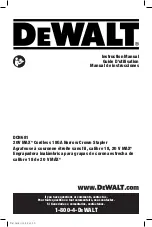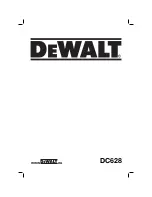
Los anillos en O de la cubierta de la válvula
del gatillo están dañados
Los tornillos de la cubierta están flojos
Los anillos en O están dañados
La cubierta está dañada
Los tornillos están flojos
El empaque está dañado
La cubierta está desgastada
La boquilla está sucia
La suciedad o daños evitan el
desplazamiento libre de los sujetadores o
el mecanismo de impulso en el cargador
El resorte del mecanismo de impulso está
dañado
El flujo de aire hacia la herramienta es
inadecuado
El anillo en O del pistón está desgastado o le
falta lubricación
Los anillos en O de la válvula del gatillo
están dañados
Hay fugas de aire
Hay una fuga en el empaque de la tapa
La herramienta no está bien lubricada
El resorte de la tapa del cilindro está roto
El orificio de salida de la tapa está obstruído
La guía del mecanismo de impulso está
desgastada
Los sujetadores no son del tamaño
adecuado.
Los sujetadores están doblados
Los tornillos del cargador o de la boquilla están
flojos
El mecanismo de impulso está dañado
Hay una fuga de aire en el
área de la válvula del gatillo
Hay una fuga de aire entre
la cubierta y la boquilla
Hay una fuga de aire entre
la cubierta y la tapa
La herramienta deja de
clavar un sujetador
La herramienta funciona
lentamente o pierde su
potencia
Hay sujetadores atascados
en la herramienta
Debe reemplazar los anillos en O y chequear el funcio-
namiento del elemento de funcionamiento al contacto
Debe apretar los tornillos
Debe reemplazar los anillos en O
Debe reemplazar la defensa
Debe apretar los tornillos
Debe reemplazar el empaque
Debe reemplazar la cubierta
Debe limpiar el canal del sistema de impulso
Debe limpiar el cargador
Debe reemplazar el resorte
Cheque las conexiones, la manguera o el compresor
Debe reemplazar los anillos en O. Lubríquelos.
Debe reemplazar los anillos en O
Debe apretar los tornillos y las conexiones
Debe reemplazar el empaque
Necesita lubricar la herramienta
Debe reemplazar el resorte
Debe reemplazar las partes internas dañadas
Debe reemplazar la guía
Debe usar los sujetadores recomendados para esta
herramienta
Reemplácelos con sujetadores en buenas condiciones
Debe apretar los tornillos
Debe reemplazar el mecanismo de impulso de
sujetadores
27 Sp
Modelo SB504000
Guía de Diagnóstico de Averías
Deje de usar la herramienta inmediatamente si alguno de los siguientes problemas ocurre.
Podría resultar en heridas graves. Cualquier reparación o reemplazo de piezas los debe hacer
un técnico calificado de servicio o un centro autorizado de servicio.
Problema
Causa
Solución
2
General Safety
Information
(Continued)
OPERATOR’S RESPONSIBILITY:
The tool operator is responsible for:
•
Reading and understanding tool
labels and manual.
• Selecting an appropriate tool
actuation system, taking into
consideration the work application
for which the tool is used.
•
The safe use of the tool.
•
Ensuring that the tool is
used only when the
operator and all other
personnel in the work
area are wearing ANSI
Z87 eye protection equipment, and
when required, other appropriate
protection equipment such as head,
hearing and foot protection
equipment. Serious eye or
permanent hearing loss could
result.
•
Assuring that the tool is kept in safe
working order as described in this
manual.
EMPLOYER’S RESPONSIBILITY:
• Selecting an appropriate tool
actuation system, taking into
consideration the work application
for which the tool is used.
•
Ensuring that this manual is
available to operators and
personnel performing maintenance.
•
The safe use of the tool.
•
Enforcing that the tool
is used only when the
operator and all other
personnel in the work
area are wearing ANSI Z87 eye
protection equipment, and when
required, other appropriate
protection equipment such as head,
hearing and foot protection
equipment. Serious eye or
permanent hearing loss could
result.
•
Assuring that the tool is kept in safe
working order as described in this
manual.
•
Assuring the proper maintenance of
all tools in employer’s possession.
•
Ensuring that tools which require
repair are not further used before
repair. Tags and physical
segregation are recommended
means of control.
Read and understand
tool labels and manual.
Failure to follow
warnings, dangers, and
cautions could result in
DEATH or SERIOUS INJURY.
Do not use any type of
reactive gases,
including, but not
limited to, oxygen and
combustible gases, as a
power source. Use
filtered, lubricated, regulated
compressed air only. Use of a
reactive gas instead of compressed
air may cause the tool to explode
which will cause death or serious
personal injury.
Use only a pressure-
regulated compressed
air source to limit the
air pressure supplied to
the tool. The regulated
pressure must not exceed 120 psi. If
the regulator fails, the pressure
delivered to the tool must not
exceed 200 psi. The tool could
explode which will cause death or
serious personal injury.
Never use gasoline or
other flammable liquids
to clean the tool. Never
use the tool in the
presence of flammable
liquids or gases. Vapors could ignite
by a spark and cause an explosion
which will result in death or serious
personal injury.
Always remain in a
firmly balanced position
when using or handling
the tool.
Do not remove, tamper
with, or otherwise cause
the Work Contact
Element (WCE) or
trigger to become
inoperable. Do not operate any tool
which has been modified in a like
fashion. Death or serious personal
injury could result.
Do not touch the trigger
unless driving fasteners.
Never attach air line to
tool or carry tool while
touching the trigger.
The tool could eject a fastener which
will result in death or serious
personal injury.
Operating Instructions
• REQUIRES:
1.3 SCFM with 10 fas-
teners per minute @ 90 psi
• AIR INLET:
1/4" NPT
• MAGAZINE CAPACITY:
100 fasteners per load, 18 gauge
• BRADS:
3/8" to 2"
• STAPLES:
1/2" to 1 1/2"; 1/4" crown
• WEIGHT:
3 lbs., 4 oz.
• LENGTH:
9 3/4"
• HEIGHT:
10"
• MAXIMUM PRESSURE:
120 psi
• PRESSURE RANGE:
60 - 120 psi
Tool Components And Specifications
www.chpower.com
Cap exhaust
Warning label
Latch button
Magazine
Fastener discharge area
Work contact element (WCE)
Trigger
Quick clear nose
O
CO
2
120 psi
MAX.
































